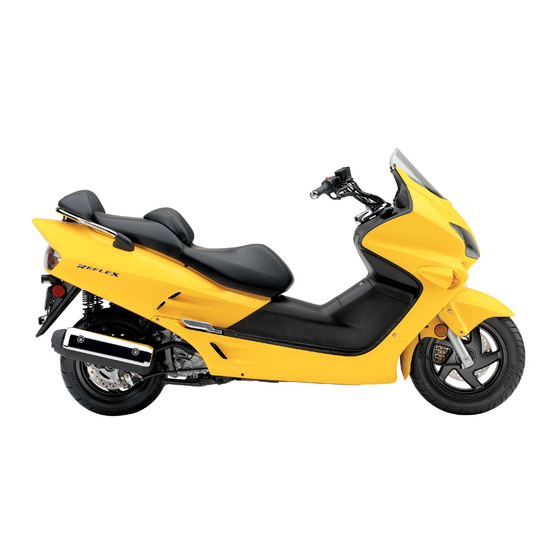
Table of Contents
Advertisement
Quick Links
This manual should be considered a permanent part of the scooter and should remain with
the scooter when it is resold.
This Owner's Manual covers all versions of the
NSS250
model. You may find
descriptions and features that are not found on your particular model.
All illustrations are based on the
NSS250A
model.
This publication includes the latest production information available before printing. Honda
Motor Co., Ltd. reserves the right to make changes at any time without notice and without
incurring any obligation.
No part of this publication may be reproduced without written permission.
2004 Honda Motor Co., Ltd.
Advertisement
Chapters
Table of Contents

Summarization of Contents
A Few Words About Safety
Safety Messages
Information alerting to potential hazards that could hurt you or others.
Safety Labels
Information or warnings provided on labels attached to the scooter.
Scooter Safety
Important Safety Information
Key recommendations for safe riding and rider protection.
Accessories & Modifications
Guidelines for modifying the scooter and using accessories.
Safety Labels
Warnings and safety information provided on scooter labels.
Instruments & Controls
Component Locations
Identifies the location of various gauges, indicators, and controls.
Gauges & Indicators
Explains the function of the scooter's gauges and warning indicators.
Digital Clock
Instructions on how to set and adjust the digital clock display.
Ignition Switch
Details on the ignition switch for starting and steering lock.
Start Button & Engine Stop Switch
Operation of the start and engine stop switches for starting/stopping.
Headlight Dimmer & Turn Signal Switches
How to operate headlight dimmer and turn signal switches.
Horn Button & Parking Brake Lock
Operation of the horn button and parking brake lock mechanism.
Before Riding
Are You Ready to Ride?
Evaluating rider readiness and necessary preparations before riding.
Protective Apparel
Recommendations for essential protective clothing and gear for riding.
Rider Training
Importance of rider training courses and skill development.
Is Your Scooter Ready to Ride?
Performing pre-ride inspections and checks for scooter readiness.
Pre-ride Inspection
Key checks to perform on the scooter before each ride for safety.
Load Limits & Guidelines
Information on maximum weight capacity and proper cargo loading.
Cargo Compartments
Details on using the center and glove compartments for storage.
Comfort & Convenience
Features for rider comfort and convenience, like map box and backrest.
Basic Operation & Riding
Safe Riding Precautions
General precautions to ensure safe riding practices and hazard avoidance.
Starting & Stopping the Engine
Step-by-step procedures for starting and stopping the scooter's engine.
Riding
Instructions on mounting, balancing, and maneuvering the scooter while riding.
Braking
Techniques for effective braking, including combined system and ABS.
Parking
Proper procedures for parking the scooter securely, including steering lock.
Riding with a Passenger or Cargo
Guidelines for safely carrying passengers and cargo on the scooter.
Servicing Your Honda
Before You Service Your Honda
Preparations and considerations before performing maintenance tasks.
Maintenance Safety
Important safety precautions and warnings related to scooter maintenance.
Periodic Maintenance
Recommended checks and tasks to perform periodically for upkeep.
Maintenance Schedule
A schedule outlining required maintenance and service intervals.
Service Preparations
Steps and considerations before beginning service tasks on the scooter.
Service Procedures
Detailed instructions for performing various maintenance tasks and procedures.
Engine
Maintenance and adjustments related to the scooter's engine components.
Brakes
Information on brake system maintenance, fluid, and pad wear.
Tires
Guidelines for tire inspection, air pressure, and replacement.
Side Stand
Checks and maintenance for the side stand and its ignition cut-off system.
Battery
Maintenance, storage, and charging procedures for the scooter's battery.
Appearance Care
Guidelines for cleaning, polishing, and maintaining the scooter's appearance.
Tips
Helpful tips on storing, transporting, and environmentally responsible ownership.
Taking Care of the Unexpected
General Guidelines
General advice for handling problems encountered while riding.
If Your Engine Quits or Won’t Start
Troubleshooting steps for engine starting issues and operational problems.
If You Have a Flat Tire
Procedures for dealing with flat tires, including temporary repairs and transport.
If Your Engine Overheats
Steps to take when the engine temperature gauge indicates overheating.
If a Fuse Blows
Troubleshooting steps for electrical issues caused by blown fuses.
If You Crash
Actions to take after an accident, including safety checks and damage assessment.
If You Lose Your Key
Procedures and advice for dealing with lost scooter keys.
If Your Battery is Low (or Dead)
Steps to take if the scooter battery is low or dead.
Technical Information
Vehicle Identification
Locating and recording VIN, frame, and engine serial numbers.
Specifications
Detailed technical specifications for the scooter's components and systems.
Break-in Guidelines
Recommended procedures for breaking in the new scooter's engine.
Emission Control Systems
Information on exhaust and evaporative emission control systems.
Catalytic Converter
Details on the function and maintenance of the catalytic converter.
Oxygenated Fuels
Information about using oxygenated fuels and their effect on the scooter.
Consumer Information
Authorized Manuals
Information on ordering service and owner's manuals from Helm, Inc.
Warranty Coverage
Details on the scooter's warranty coverage, restrictions, and exclusions.
Warranty Service
How to obtain warranty service and what to do if dissatisfied with dealer handling.
Contacting Honda
Information on how to contact Honda for questions or feedback.
Your Honda Dealer
Information on dealer services, protection plans, and rider education.
The Honda Rider’s Club
Benefits and how to join the Honda Rider’s Club of America (HRCA).
Reporting Safety Defects
How to report vehicle safety defects to NHTSA and Honda.
Quick Reference
How To Avoid Costly Repairs
Tips on proper maintenance to prevent expensive repairs.
















Need help?
Do you have a question about the ABS Sport and is the answer not in the manual?
Questions and answers